|
|
Updated as per James P. Tuttle's The Hawk Moths of North America, May 20, 2011
Updated as per personal communication with Walt N Tina Davis (Amphion floridensis), May 20, 2011
Updated as per personal communication with Walt N Tina Davis (Agrius cingulata), October 4, 2011
Updated as per BAMONA, October 4, 2011; August 6, 2014
|
Cape May County, New Jersey
Sphingidae
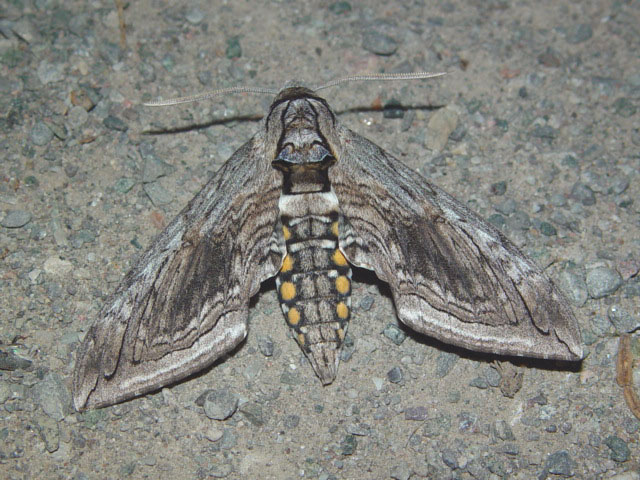
Manduca quinquemaculatus, courtesy of Tim Dyson.
I spent my early years in northern New Jersey and
now reside in Montague, Prince Edward Island. I still have a frame of
Sphingidae specimens from Hunterdon County, New Jersey, done up over
forty years ago. It contains Lintneria eremitus, Sphinx gordius,
Paonias myops, Smerinthus jamaicensis, Darapsa choerilus, Darapsa
myron, Sphecodina abbottii, Hyles lineata and a stray
Xylophanes tersa.
I can also remember seeing Manduca sexta, Manduca quinquemaculatus,
Manduca jasminearum, Ceratomia catalpae, Ceratomia amyntor, Ceratomia
undulosa, Paonias excaecata, Amorpha juglandis, Eumorpha pandorus,
Hemaris thysbe (day flier) and Hyles lineata at
lights or along the train tracks (Union County, N.J.) at night
nectaring at phlox. The Hemaris species could often be
encountered during the day around the butterfly bushes or near the
honey suckle vines.
Some of these species I now see at lights on P.E.I.; I have reared
most of the local ones.
With so many species from Cape May County common to one or
the other or both of my homes, the memories are flooding back!
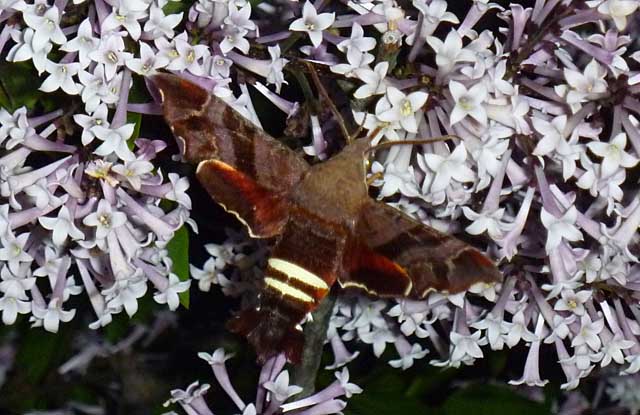
Amphion floridensis, Stone Harbor, Cape May County, New Jersey,
May 19, 2011, courtesy of Walt N Tina Davis.
Forty-six Sphingidae species are listed for New Jersey on the BAMONA website as of August 6, 2014. Not all of the species are reported or anticipated in
Cape May County.
Thirty-three species: Agrius cingulata, Amorpha juglandis, Ceratomia amyntor, C. catalpae, C. undulosa, Cocytius antaeus,
Dolba hyloeus, Lapara bombycoides, L. coniferarum, Manduca quinquemaculatus, M. rustica, M. sexta, Pachysphinx modesta,
Paonias astylus, P. excaecata, P. myops, Paratraea plebeja, Smerinthus jamaicensis, Sphinx drupiferarum,
S. gordius,
S. kalmiae,
Amphion floridensis,
Cautethia grotei,
Darapsa choerilus,
D. myron,
D. versicolor,
Deidamia inscriptum,
Eumorpha achemon,
E. pandorus,
Hemaris diffinis,
H. thysbe,
Hyles lineata,
Xylophanes tersa are reported on BAMONA as of August 6, 2014.
Two of those species, Cocytius antaeus and Cautethia grotei, would be adult strays without breeding populations in Cape May County.
It is hoped that this checklist, with the thumbnails and notes, will help you quickly identify the caterpillars you are likely to encounter.
I (William Oehlke) have added many species not listed by BAMONA which I expect are present or might be present, although unreported.
Please help me develop this list with improved, documented accuracy by sending sightings (species, date, location), preferably with an
electronic image, via email to Bill Oehlke.
Please also forward you sightings to BAMONA, an excellent on-line resource.
Thanks again to Walt and Tina Davis for the following image of Agrius cingulata, the Pink-spotted Hawkmoth.
I do not believe that there are breeding populations in New Jersey. It is more likely a wind assisted stray from further south.
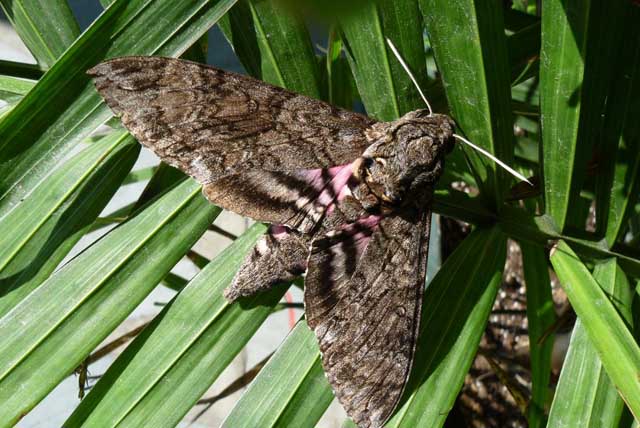
Agrius cingulata, Stone Harbor, Cape May County, New Jersey,
October 4, 2011, courtesy of Walt N Tina Davis
Visit Cape May County Sphingidae Larvae: Caterpillars; Hornworms
Visit New Jersey Catocala: Underwing Moths
If you are travelling, you can find active Sphingidae checklists for all countries in North, Central, and South America and the Caribbbean via the links at
North, Central, South American Sphingidae checklists
Sphinginae subfamily
Sphingini tribe:
 |
Agrius cingulata,
BAMONA/WNTD,
Pink-spotted Hawkmoth,
fall stray.
This moth is a very strong flier, but would only make its way to
Cape May as a rare stray. There are not too many records from
New York state, but records exist for NJ and CT.
|
Agrius cingulata, Stone Harbor, October 4, 2011, Walt N Tina Davis
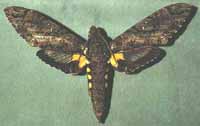
|
Cocytius antaeus,
BAMONA,
The Giant Sphinx,
stray.
This moth is a very strong flier, but would only make its way to
Cape May as a rare stray. There are not too many records from
northen states.
|
 |
Ceratomia amyntor,
BAMONA,
the Elm Sphinx or Four-horned Sphinx.
This moth is officially recorded in Cape May.
Larvae feed on Elm (Ulmus), birch (Betula), basswood (Tilia), and
cherry (Prunus). |
 |
Ceratomia catalpae
BAMONA,
the Catalpa Sphinx.
This species is recorded for Cape May.
I saw them in great numbers in New Jersey. The larvae feed in large groups and are much more
spectacular than the moths.
Catalpa is the larval host. |
 |
Ceratomia undulosa
BAMONA,
the Waved Sphinx.
This moth is recorded in Cape May. I have seen them as far north as P.E.I. in
eastern Canada, and took them in New Jersey.
It is named for the wavy lines on the forewings. |
 |
Dolba hyloeus,
BAMONA
the Pawpaw Sphinx.
This moth is recorded in Cape May. It is widely reported in
New Jersey and Connecticut.
|
 |
Lapara bombycoides
BAMONA,
the Northern Pine Sphinx.
This moth is reported from Cape May. If you have pines, you
probably have this species. It flies on P.E.I.
|
 |
Lapara coniferarum
BAMONA,
the Southern Pine Sphinx.
this moth is reported from Cape May, and it is widely reported in
New Jersey and along the coast in Connecticut and Masachusetts.
If you've got pines, this species is likely present. |
 | This species is not reported in Cape May. Generally it is not
widely reported, but I suspect it is in Cape May County. |
 |
Manduca jasminearum
WO,
the Ash Sphinx.
This species is not officially recorded in Cape May.
It is reported in New Jersey, southeastern New York and Connecticut.
It might be present in Cape May County.
|
 |
Manduca quinquemaculatus,
WO,
the Five-spotted Hawkmoth.
This species is recorded in Cape May, and has been seen in
nearby counties.
I suspect if you grow tomatoes, you are likely to encounter it.
|
 |
Manduca rustica
WO,
the Rustic Sphinx.
This species is not (now is) recorded in Cape May, but it has been taken in
counties in northeastern and central eastern New Jersey. I would not
be surprised to get a report. Look for three large yellow spots
on each side of the abdomen. possible stray from further south
|
 |
Manduca sexta
BAMONA,
the Carolina Sphinx.
This species is recorded in Cape May.
If you grow tomatoes, you have probably encountered it.
Larvae get very large and can strip a tomato plant.
|
 |
Paratrea plebeja,
BAMONA,
the Plebeian Sphinx. The upperside of the forewing is gray with indistinct black and
white markings. There is a series of black dashes
from the base to the tip, and a small white cell spot.
|
 |
Sphinx chersis,
WO,
the Northern Ash Sphinx or Great Ash Sphinx. This species is not reported in Cape May. Larval hosts are ash,
lilac, privet, cherry, and quaking aspen. unlikely
|
 | This species is officially reported in Cape May. We have them
on P.E.I., but I do not see them nearly as frequently
as I see the other Sphingidae. |
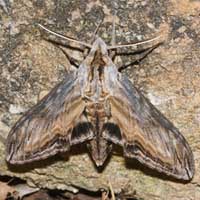 | This species is not reported in Cape May, and generally it is
not widely reported anywhere. Similar to S. kalmiae but lacks the dark bar
along the fw inner margin.
remote possibility |
 | This species is reported in Cape May. Generally it is
widely reported in neighbouring counties.
Note the pm line, absent in Sphinx poecila which flies
more to the north. |
 |
Sphinx kalmiae
BAMONA,
the Laurel Sphinx.
This species is reported in Cape May.
I have taken them on P.E.I., Canada, and reared them on
lilac. At rest the hindwings are usually completely covered.
|
Smerinthini Tribe:
 |
Amorpha juglandis
BAMONA, Walnut Sphinx.
This moth is fairly widely reported to the north and west
of as well as in Cape May.
This is the first Sphinx species I reared as a boy in New Jersey.
See the file for the female; she is different. |
 |
Pachysphinx modesta
BAMONA,
the Modest Sphinx or Poplar Sphinx.
This moth is recorded in Cape May County. It is fond of poplars and
willows.
They are common on Prince Edward Island. |
 |
Paonias astylus
BAMONA,
the Huckleberry Sphinx
This appears to be an uncommon species. They are officially
recorded for Cape May, and they are reported for northeastern
New Jersey and Connecticut.
|
 |
Paonias excaecata,
BAMONA,
the Blinded Sphinx.
Named for the dull grey-blue spot (minus dark pupil) in the hindwing,
this moth has a wide distribution and is probably common in Cape May
County.
I regularly see them on Prince Edward Island, and they are reported
as far south as Florida. |
 |
Paonias myops,
BAMONA,
the Small-eyed Sphinx.
Named for the small eye-spot in the hindwing, this moth has a wide distribution
and is probably common in Cape May County.
I regularly see them on Prince Edward Island, and they are reported
as far south as Florida.
|
 |
Smerinthus jamaicensis
BAMONA,
the Twin-spotted Sphinx.
This moth is widely distributed and fairly common.
Along the East Coast, it flies from P.E.I. to Florida. |
Macroglossinae subfamily
Dilophonotini tribe:
See Hemaris comparison to help distinguish
the next three species.
 |
Hemaris thysbe,
BAMONA,
the Hummingbird Clearwing.
This interesting day flier is reported in Cape May, and
is widely reported to the north and west.
They are widely distributed in the east from P.E.I. to Florida. |
 |
Hemaris diffinis,
BAMONA,
the Snowberry Clearwing or Bumblebee Moth.
This moth is widespread and has been recorded in Cape May and
in northwestern N.J. and southeastern N.Y. and Connecticut.
|
 |
Hemaris gracilis,
WO,
the Slender Clearwing or Graceful Clearwing.
This day-flying moth is less common and has not been recorded in
Cape May, but has been seen in northeastern N.J. and
southeastern N.Y. unlikely
|
Philampelini tribe:
 |
Eumorpha achemon
BAMONA,
the Achemon Sphinx.
This moth is reported for Cape May, and it is fairly often reported
along the coast from southern New Jersey
to central Maine.
Note the differences between this moth and the Pandorus Sphinx. |
 |
Eumorpha pandorus
BAMONA,
the Pandorus Sphinx.
If you have Grape or Virginia Creeper nearby, then you probably have
this species.
I often get asked to identify larvae from areas not
previously reported. |
Macroglossini tribe:
 |
Amphion floridensis
BAMONA/WNTD,
the Nessus Sphinx.
This day flier is widely distributed. If you have Virginia Creeper, you
probably have the Nessus Sphinx. It is reported from
Richmond.
Two bright, distinct, narrow yellow
bands are often visible on the abdomen.
|
Amphion floridensis Stone Harbor, May 19, 2011, Walt N Tina Davis.
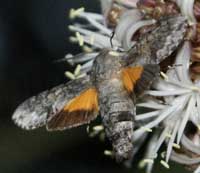 |
Cautethia grotei
BAMONA,
the Grote's Sphinx.
This species is rarely recorded in the U.S., but there are sightings
in the east from Florida, South Carolina, New Jersey, New York,
Massachusetts and
New Hampshire.
There are reports from Cape May.
|
 |
Darapsa choerilus
BAMONA,
the Azalea Sphinx.
They are common in New Jersey and common
here on Prince Edward Island.
You will often see this species listed as Darapsa pholus,
especially in older literature.
It is confirmed for Cape May. |
 |
Darapsa myron,
BAMONA,
the Virginia Creeper Sphinx or the Grapevine Sphinx.
This moth is recorded on the U.S.G.S. site for Cape May County
It is widely reported as far north as southern Maine. If you have the
foodplants indicated in the common names, you probably have this
species nearby. |
 |
Darapsa versicolor
BAMONA,
the Hydrangea Sphinx.
If you have hydrangea growing near a stream, then you may have the
Hydrangea Sphinx.
It has been reported in Cape May and in
southeastern New York and
northeastern New Jersey as well.
|
 |
Deidamia inscriptum
BAMONA,
the Lettered Sphinx.
This species has been recorded in Cape May and nearby areas.
Grape (Vitis), ampelopsis (Ampelopsis), and Virginia creeper (Parthenocissus) all serve as larval hosts.
|
 |
Hyles lineata,
BAMONA,
the White-lined Sphinx.
This species is reported from Cape May County. It has
strong migrating tendancies from much further south.
There are records from New Hampshire and Maine.
|
 |
Sphecodina abbottii
WO,
the Abbott's Sphinx.
This moth is very much under reported across the United States. It
is a rapid day flier so is probably not in too many collections.
Grape is a popular larval host. It is likely in Cape May County.
|
 |
Xylophanes tersa,
BAMONA,
the Tersa Sphinx.
This moth is much more common to the south. It is a strong migrant,
however, and may establish itself in Cape May periodically.
|
|
|
Enjoy some of nature's wonderments, giant silk moth cocoons.
These cocoons are for sale winter and fall. Beautiful Saturniidae moths will emerge the following spring and summer.
Read Actias luna rearing article. Additional online help available.
Use your browser "Back" button to return to the previous page.
This page is brought to you by Bill Oehlke and the
WLSS. Pages are on space rented from Bizland. If you would like
to become a "Patron of the Sphingidae Site", contact Bill.
Please send sightings/images to Bill. I will do my best to respond to
requests for identification help.
 | 
Show appreciation for this site by clicking on flashing butterfly to the left.
The link will take you to a page with links to many insect sites. |
This website has been created and is maintained by Bill Oehlke without government or institutional financial assistance. All expenses, ie., text reference
support material, webspace rental from Bizland, computer repairs/replacements, backups systems, software for image adjustments (Adobe Photoshop; L-View),
ftp software, anti-virus protection, scanner, etc. are my own.
I very much appreciate all the many images that have been sent to me, or of which I have been granted permission to copy and post from other websites.
All images on this site remain the property of respective photographers.
If you would like to contribute to the maintenace of this website by sending a contribution to
Bill Oehlke
Box 476
155 Peardon Road
Montague, Prince Edward Island, C0A1R0
Canada
your donation would be much appreciated and would be used for
1) paying for webspace rental;
2) paying for computer maintenance and software upgrades;
3) purchases of additional text reference material (journals and books) in anticipation of expanding the site to a worldwide Sphingidae site;
4) helping to pay my daughter's tuition (completed spring 2013); with anything left over going to humanitarian aid.
If you are mailing a check from USA, please use $0.85 postage. ($1.15 is 2014 rate so check with post office as rates seem to be rising almost annually.)
Donations can also be made through Paypal via the button below.




